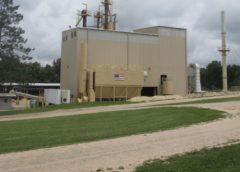Ohio Basic Minerals Reinvents Itself with New Equipment and a New Direction.
By Mark S. Kuhar
|
|
| Ohio Basic Minerals is located in Jackson, Ohio. |
 |
| The company installed a new Trio screening plant. |
 |
| Screened material is stored in silos. |
 |
| Midwestern screens separate material into different products. |
The rolling hills and countryside of southern Ohio are certainly scenic, but it is what lies below those hills that matters most to producers. The ample sand deposits and glacial moraine deposited after the last ice age offer unlimited potential to create a successful aggregates operation. And Ohio Basic Minerals in Jackson, Ohio, is certainly that.
But it wasn’t always that way. According to company President Carey Carlson, the operation had fallen on hard times before he acquired the facility in May 2017. “The equipment was old and their operational structure just wasn’t working,” he said. “With investment backing from Resilience Capital, we took over the plant and restructured almost everything. Now we are headed in the right direction.”
Unique Approach
While most aggregates operations excavate and process on-site, Ohio Basic Minerals does things a little bit different. Although the company owns its own deposit with about 1,000 acres under lease, that land is too far away from the production facility to figure into its current production process.
“In the future, we may find a way to integrate that property into our business plan, but for now it is not cost-effective to source our raw materials from there,” Carlson said.
Instead, the company buys its raw material from a third party. “We actually consider ourselves a finishing plant,” he said.
Processing Begins
The screening process at Ohio Basic Minerals begins with washed material being trucked in from a nearby Best Sand operation, owned by Covia. That haul and dump process is handled by a local firm, Davis Trucking.
“That may seem counter-intuitive,” Carlson said, “But financially this system works great for us.”
At the dump piles, several Komatsu WA500 loaders cycle between the raw material piles and a new Trio processing plant. Trio is now part of the Weir Group.
“The Trio plant has been an excellent addition to our operation,” Carlson said, noting that he first learned about the equipment after reading about it in Rock Products.
The Trio plant features an 8- x 16-ft. horizontal triple-deck screen. The plant makes four products, 1- x ¾-in. overs; ½ x ¼ in.; ¼ x 1/8 in.; and a sand product.
One of the preeminent features that contributes to the success of Ohio Basic Minerals is a sophisticated bagging operation. After the Trio puts the material on the ground, the gravel products are transported to storage silos where the material is bagged using two Chantland automatic bagging systems. “These are brand-new systems that we installed,” Carlson said. “We can fill smaller, 50-lb. bags and we can even do 3,000 lb. or 4,000 lb. super sacks on pallets. It is very efficient.”
Screening
The sand product is sent to a screening building where four, five-deck Midwestern screen decks fitted with synthetic coated screen media make seven industrial sand products:
- 10/20.
- 16/30.
- 30/50.
- 40/70.
- Minus 100.
- 6/12.
- 100 mesh (70/100).
“We also do blended products,” Carlson said. “The previous ownership produced 89 percent of its product for hydraulic fracturing, and when the market went south a few years ago, it really impacted their business. We still produce frac sand but we are diversifying our products to more strongly service industrial sand markets.”
After screening, a Masaba conveying system sends finished product to seven storage silos. All of the sand products, whether industrial or frac, are dried using a 75-tph Stark air dryer. Material is dried between 180 and 230 degrees F.
Contined on page 26
Bagging Sand
 |
| Special equipment moves the filled bags onto pallets. |
 |
| Chantland automatic bagging system. |
Carey Carlson: Industry Experience
 |
| Carey Carlson |

